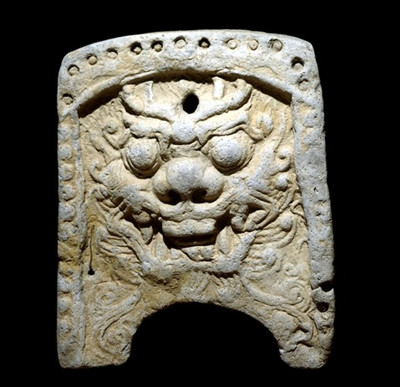It's got a squashed nose, bulging eyes, small horns, and abundant whiskers. In fact, the face looks like a cross between a Chinese dragon and a Pekingese dog, and not friendly at all! It looks a bit like an oriental gargoyle, and that is pretty well what it was.It would have had a similar position to a gargoyle, high up on a temple or a grand house. The features of the face when you look at them closely are pretty rough, and it's obvious that it's been made by pushing the wet clay into a fairly simple mould. This is clearly a mass-produced object. But that is why it's so interesting, because this is just one of tens of thousands designed to cover roofs that would once have been thatched, but in prosperous Silla Korea, were tiled with objects like this.
闊鼻,鼓眼,細角,胡須很多,看起來像是中國龍與京巴的混合體。它十分類似同期產于中國唐朝的瓦片,但它絕非中國制造。中國龍通常有一張大嘴,而這個動物的嘴小且具有攻擊性。整個瓦片的造型也頗為粗獷,一點兒也不中國。它看起來就像個東方的滴水獸,而這也正是它的用途。它曾被安放的位置與西方的滴水獸類似,高踞于廟宇或豪宅的屋頂。瓦片的面部細節極為粗糖,顯然只是將濕土按壓進一個簡單的模具制成的。它很明顯是大規模量產的瓦片之一,而這正是我們對它感興趣的原因。人們的屋 頂曾經只用茅草覆蓋,而今在繁華的新羅,人們制造出成千上萬件類似的瓦片,覆蓋在屋頂之上。
Why did the Silla want to build such a grand capital, and why did they need so many new houses? The Korean specialist Jane Portal explains:
朝鮮半島專家白珍博士解釋了新羅為何要將慶州修建得如此繁華,又為什么需要如此多的新建筑:
"The city of Kyongju was based on the Chinese capital Chang'an, which was at the time the biggest city in the world, and Kyongju developed hugely once Silla had unified the Korean peninsula, or most of it. A lot of the aristocrats from the kingdoms which were defeated by Silla had to come and live in Kyongju, and they had magnificent houses with tiled roofs. And this was a new thing, to have tiled roofs, so this tile would have been a sort of status symbol for them."
慶州是模仿中國的首都長安建造的。長安是當時世界上最大的城市之一。新羅征服了朝鮮半島的大部分地區之后,慶州立刻飛速發展起來。許多戰敗國的王公貴族來到慶州居住,他們需要覆瓦的豪宅。瓦頂建筑對當時的慶州來說是新鮮事物,因此這樣的瓦片是某種地位的象征。












